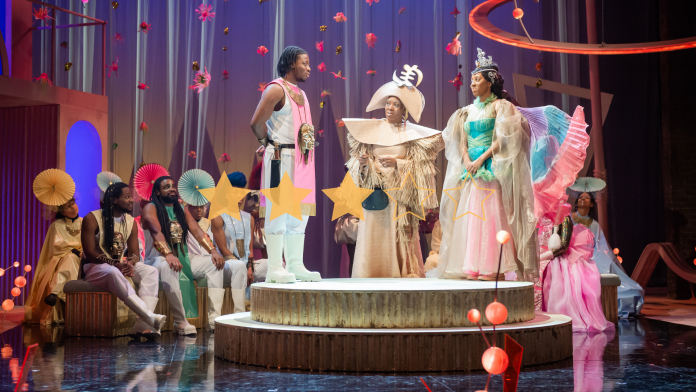Much Ado About Nothing is a romantic comedy, originally set in the Italian city of Messina. In the Royal Shakespeare Company’s (RSC) latest version, however, the city of Messina is actually part of a futuristic world. It is the rendering of this world, using the aesthetics of Afrofuturism in particular, through the sets and costumes that was the real standout of the show.
Set designer Jemima Robinson created a stunning set that could be easily transformed between scenes, including a beautiful gold fountain centrepiece for the masquerade ball and then, later, a golden and pastel blue dais and matching benches for the wedding set. She also used all available aspects of the stage, such as the ceiling, with hanging ropes used for the brash entrance of Don Pedra (Ann Ogbomo), Benedick (Luke Wilson) and Claudio (Mohammed Mansaray). In the wedding scene beautiful vines of pink flowers descend from the ceiling. The wedding set was one of my favourites because it brought the bright and futuristic set to life, making use of the whole space. There was also the reveal of Hero’s infidelity at the end of the first half, with a huge cutout window appearing at the back of the stage and towering over the broken-hearted Claudio on stage, an impactful final visual.
Similarly, the costumes, designed by Melissa Simon-Hartman, were also excellent especially in the masquerade ball with all the characters wearing different gold outfits and masks, making it easy for the audience to identify each character as the couples came to the front of the stage to perform their individual scenes. The ball continuing in well-choreographed motion in the background. As with the set the costumes grounded the Shakespearean language in this space-age setting, making the marriage of the two understandable rather than confusing.
In terms of the acting, Beatrice (Akiya Henry) and Benedick delivered the strongest performances, working well as a couple and individually. Henry went for a very exaggerated performance style that worked well with the setting and the comedic purpose of the role. The gender-swapping of Don Pedro into Don Pedra also worked fairly well and Ann Ogbomo’s performance was very good. On the other hand, Leonato (Kevin N Golding) was not as strong as some of the rest of the cast, his role not having quite the emotional impact it needed especially in the wedding scene.
It was also fantastic to see a majority Black cast performing Shakespeare, something we do not see enough in theatre. Furthermore, the use of Black hair throughout the show was very intentional with Hero (Taya Ming) and Beatrice frequently switching between different Black hairstyles. Some of my favourites were Hero’s elaborate heart shaped locs at the start of the show and Beatrice’s white afro during the masquerade ball.
Unfortunately, the second half was not as strong as the first half. In particular, the introduction of the nightwatch brought the show down because they chose to use a very contrasting comedic tone for those scenes which jarred with the rest of the production. In addition, the costumes of the nightwatch were very different from the rest of the production and looked like they’d come from an entirely different show, in particular the flashing glasses worn by Dogberry (Karen Henthorn) were distracting.
Overall, despite having a few weak spots, the production is well-worth seeing for the set and the costumes alone.
Words by Cerys Gardner
Support The Indiependent
We’re trying to raise £200 a month to help cover our operational costs. This includes our ‘Writer of the Month’ awards, where we recognise the amazing work produced by our contributor team. If you’ve enjoyed reading our site, we’d really appreciate it if you could donate to The Indiependent. Whether you can give £1 or £10, you’d be making a huge difference to our small team.
